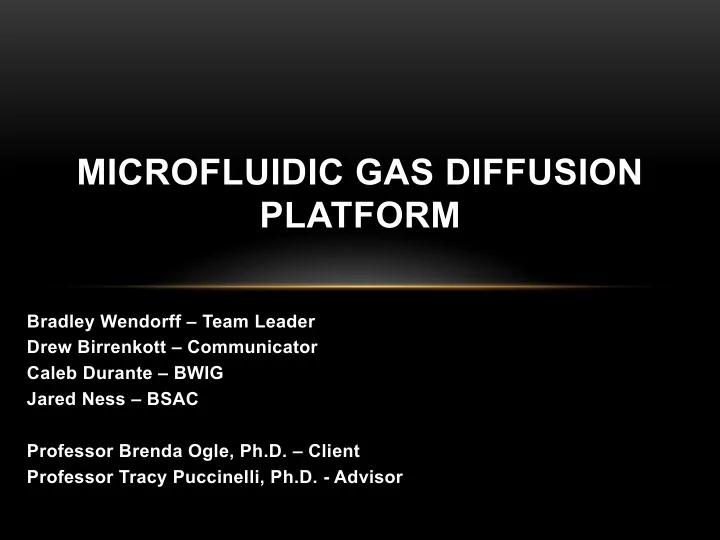

MICROFLUIDIC GAS DIFFUSION PLATFORM Bradley Wendorff – Team Leader Drew Birrenkott – Communicator Caleb Durante – BWIG Jared Ness – BSAC Professor Brenda Ogle, Ph.D. – Client Professor Tracy Puccinelli, Ph.D. - Advisor
OVERVIEW • Background – Microfluidic Devices • Client requirements and desired specifications • Critical analysis of two design elements • PDMS diffusion platform • Oxygen detection technique • Current design • Moving forward
PROBLEM STATEMENT • Need way to assess cardiac cellular response to hypoxia • Traditional hypoxia chambers non-ideal • Slow, Large & space-filling, $$$ • TASK: Develop and validate a next-generation, microfluidic-based hypoxia chamber to facilitate studies involving oxidative stress, ischemia, and reactive oxygen species (ROS)-mediated cellular pathways.
MICROFLUIDIC DEVICES • Flexible polymer matrix (PDMS) • Fabrication Process • Molded over master template • Channels cross-linked to glass • Cells seeded in fluid filled channels • Applications of microfluidics • Printer industry • Study of microbial behavior • Study of cellular behavior** Figure 1: PDMS platform connected to fluid lines (Image taken from www.dolomite.com)
DESIGN SPECIFICATIONS • Oxygen gradient range: 21% - 1% • Cannot interfere with cell culture • Master mold reusable • PDMS device one-time use • Biocompatible, non-cytoxic materials only • Operate at 37˚C in a 5% CO2 incubator Channels: 250 µ m - 500 µ m tall x 250 µ m – 750 µ m wide •
PLATFORM CHANNEL LAYOUT • Design 1 – Parallel Flow • Gas flow at a constant rate • Flow release based on pulsating solenoid manifold • Diffusion of O 2 and N 2 into micro- wells • Costly Figure 2: Top view schematic of parallel flow design.
PLATFORM CHANNEL LAYOUT N 2 O 2 • Design 2 – “Two-Channel” • O 2 and N 2 flow into gas channels • O 2 gradient forms across channels • Relatively inexpensive and simple +O 2 ---------------------------------- -O 2 Figure 3: Two channel design concept (Based on Li, et. Al 2011).
PLATFORM CHANNEL LAYOUT • Design 3 – “Oxygenator” • Requires precise microfluidic construction • Concentrations halved at each node • Can develop full spectrum gradient (0-100%) • Cell platform situated above R out Figure 4: O 2 gradient C out1 -C out8 0% - 14.2% - 28.49% - 42.82% - 57.18% - 71.53% - 85.81% - 100% (Lam, et. Al 2009)
CHANNEL DESIGN MATRIX Platform Design Factors Weight Rating (1-10) Parallel Flow Two Channel Oxygenator Ease of production 0.25 4 9 2 Span of gradient range 0.20 4 7 9 Cell-culture isolation 0.15 8 5 6 Gradient Control 0.25 8 4.5 2 Cost 0.15 1 6 7 TOTAL 1 5.15 6.425 4.75
GAS DETECTION METHODS • Thin sensor Film • Layer of Chemo-fluorescent indicator molecule • Embedded in porous matrix • Quenched by O 2 • Concentration based on fluorescent intensity • Sensor matrix replaced after each Figure 5: Representation of the thin sensor film design (Grist, et. Al 2010). experiment
GAS DETECTION METHODS • Fluorescent microparticles • Suspended in cell culture media • Coated in PDMS • Fluorescent intensity-based Figure 6: Representation of PDMS coated microparticles in solution (Grist, et. Al 2010).
GAS DETECTION METHODS • O 2 microelectrode sensor • Gives discrete measurement for one location • O 2 reduction produces voltage • O 2 is consumed Figure 7: Dissolved oxygen microelectrode (Left) and • Affects concentration dissolved oxygen sensing tips (Right) (Lim, et. Al 2009).
GAS DETECTION DESIGN MATRIX Method of Monitoring Oxygen Factors Weight Rating (1-10) Thin Sensor Film Fluorescent Particles O 2 Probe Accuracy 0.30 7 8 2 Cost 0.15 4 5 3 Ease of Use 0.25 7 4 7 Biocompatibility 0.30 8 6 8 TOTAL 1.00 6.85 5.95 5.2
PRELIMINARY DESIGN Figure 8: SolidWorks rendition of the 2 channel design (Based on Li, et. Al 2011). Figure 10: Representation of the thin Figure 9: Two channel design photo mask sensor film design (Grist, et. Al 2010). (Based on Li, et. Al 2011).
FUTURE WORK • Chemical safety training • Construct 2-channel device • Calibrate florescence detector • Integrate all design components
ACKNOWLEDGEMENTS • Professor Brenda Ogle • Professor Tracy Puccinelli • Professor John Puccinelli • Brian Freeman
REFERENCES Beebe D, M. G., Walker G. "Physics and Application of Microfluidics in Biology." Annual Review of Biomedical Engineering 4 : 261-286. Birgit Ungerböck, G. M., Verena Charwat, Peter Ertl, Torsten Mayr (2010). "Oxygen imaging in microfluidic devices with optical sensors applying color cameras." Procedia Engineeering 5 : 456-459. Eddington, e. a. (2009). "Modulating Temporal and Spatial Oxygenation over Adherent Cellular Cultures." PLoS ONE 4 (9). Grist, S. C., L. Cheung K. (2010). "Optical Oxygen Sensors for Applications in Microfluidic Cell Culture." Sensors 10 : 9286-9316. Lam R, K. M., Thorsen T. (2009). "Culturing Aerobic and Anaerobic Bacteria and Mammalian Cells with a Microfluidic Differential Oxygenator." Anal. Chem. 81 : 5918-5924. Li N., Luo C.X., Zhu X.J., Chen Y., Qi O.Y., Zhou L.P. (2011). “Microfluidic generation and dynamically switching of oxygen gradients applied to the observation of cell aerotactic behaviour.” Microelectric Engineering 88(8): 1698-1701. Lo J., S. E., Eddington D., (2010). "Oxygen Grandients for Open Well Cellular Cultures via Microfluidic Substrates." NIH Public Access: 15. Sin, A. C., K. Jamil, M. Kostov, Y. Rao, G. Shuler, M. (2004). "The Design and Fabrication of Three-Chamber Microscale Cell Culture Analog Devices with Integrated Dissolved Oxygen Sensors." Biotechnol. Prog. 20 (1): 338-345. Ungerbock, B. M., G. Charwat, V. Ertl, P. Mayr, T. (2010). "Oxygen imaging in microfluidic devices with optical sensors applying color cameras." Elsevier 5 : 456-459.
Recommend
More recommend